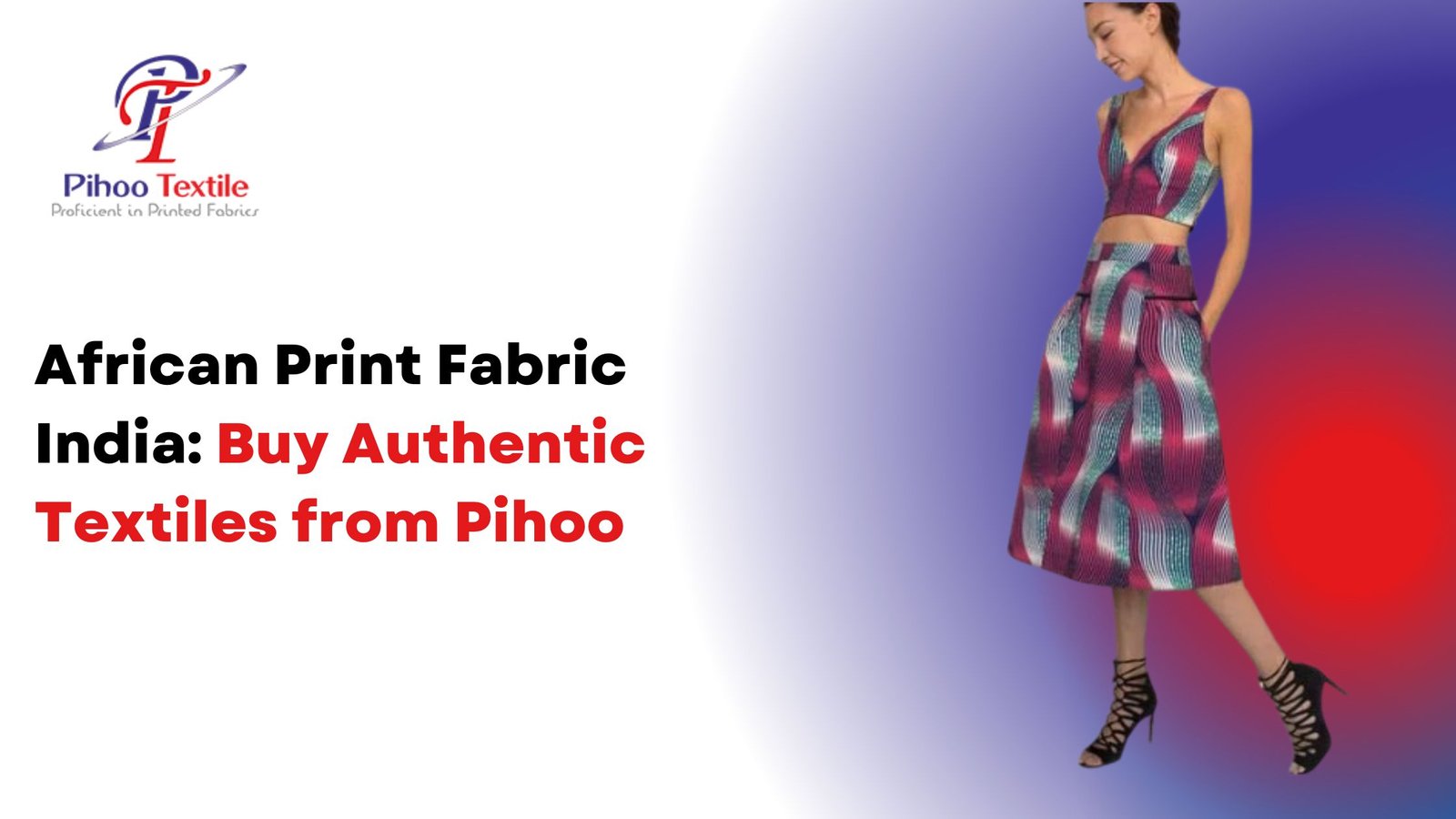African Print Fabric India: Buy Authentic Textiles from Pihoo
Introduction
Finding genuine African print fabric in India is harder than it looks. Over 70% of African-style textiles sold across Asia are low-quality imitations that fade after two washes, lose their vibrancy, and disappoint designers who need reliable materials. The real challenge is not just finding colorful patterns but securing authentic wax prints and ankara fabrics that hold up under professional use. Pihoo Textile addresses this gap by sourcing certified African prints that meet international standards for weight, texture, and color permanence.
This guide walks through what makes African fabric authentic, how to spot quality materials, and why sourcing matters for fashion creators in India.
What Makes African Print Fabric Authentic
African wax print fabric goes by several names including ankara, Dutch wax, and batik prints, but authentic pieces share distinct characteristics. The fabric originated through a unique blend of Indonesian batik techniques and African aesthetic preferences, creating textiles that became synonymous with African identity. True wax prints feature a waxed appearance on both sides, making them water-resistant and durable for daily wear.
The Weight and Texture Test
Quality African fabric weighs more than standard cotton prints. Authentic ankara and wax prints are made from 100% cotton and have a distinct heft when held in hand. The texture should feel slightly stiff when new but soften with washing while maintaining structural integrity. Low-grade alternatives use polyester blends that feel slippery or overly smooth, lacking the characteristic cotton grip that professional tailors prefer.
Color Vibrancy That Lasts
Genuine African prints use specialized wax-resist dyeing processes that lock pigments deep into cotton fibers. The colors appear equally vivid on both sides of the fabric, a hallmark of authentic production. Bright reds, oranges, greens, and yellows should maintain their intensity even after multiple wash cycles. Fading within the first few washes signals poor dye quality or synthetic fiber content that cannot hold traditional wax dyes effectively.
Why Indian Markets Need Better Sourcing
Asian imports now account for over 70% of African-style textile consumption in markets where these fabrics are popular, creating a flood of substandard materials. Chinese and Indian manufacturers produce ankara-style prints at prices far below authentic sources, but these versions skip the traditional wax-resist process. The result is fabric that looks right in the store but disappoints in application.
Fashion designers and boutique owners face a specific problem. When customers return items because colors bled or patterns scratched off, the reputation damage costs more than the initial savings from cheap fabric. Interior designers who use African prints for cushions, upholstery, or curtains need materials that can withstand sun exposure and regular cleaning without losing their appeal.
How to Identify Quality Before Purchase
The Scratch Resistance Check
Take a coin or your fingernail and lightly scratch the surface of the fabric. Authentic wax print should show no damage or color transfer. The wax coating creates a protective layer that resists surface abrasion. If the pattern scratches off easily or leaves pigment on your finger, the fabric uses inferior printing methods that will not hold up during garment construction or daily use.
Pattern Definition and Detail
High-quality African prints feature intricate, well-defined patterns with clean edges and precise color separation. Look closely at where two colors meet within a design. Authentic prints show sharp boundaries with no bleeding or blurring. The patterns should be identical on both fabric sides, though the reverse may appear slightly muted due to the wax process.
Origin Documentation
Genuine African fabrics come from specific production regions including Ghana, Nigeria, and Senegal. Reputable suppliers provide origin documentation or brand identification printed along the fabric selvedge. This strip usually includes manufacturer information, quality certifications, and sometimes care instructions. Fabrics lacking these identifiers often originate from unauthorized production facilities using shortcuts that compromise quality.
Popular Applications for African Prints in India
Fashion and Apparel Design
African prints have moved beyond traditional use into contemporary Indian fashion. Designers create fusion wear combining ankara fabrics with Indian silhouettes like kurtas, palazzos, and jacket overlays. The bold patterns work well for statement pieces, accessories, and coordinated outfits for events. Authentic fabric behaves predictably during cutting and sewing, maintaining pattern integrity through curved seams and gathering.
Home Décor and Interior Styling
The vibrant, multicolored nature of African wax prints adds energy to interior spaces. Cushion covers, table runners, curtains, and upholstery featuring these patterns create focal points in otherwise neutral rooms. The key is using African prints as accent pieces rather than covering entire surfaces, balancing their intensity with solid colors in beige, white, or charcoal.
Custom Projects and Small-Scale Production
Crafters and small business owners use African fabric for bags, shoes, headbands, and other accessories. The material’s stiffness provides structure without additional interfacing, and its distinctive patterns create instant brand recognition. Authentic fabric cuts cleanly without fraying excessively, a critical factor for small items requiring precise edges and detailed construction.
What Separates Premium Suppliers
Consistent Quality Control
Reliable textile suppliers implement inspection protocols that catch defects before fabric ships. Each bolt should maintain uniform color saturation from beginning to end, with no weak spots or printing errors. Premium suppliers also batch-test for colorfastness, ensuring that fabrics meet minimum standards for washing durability and light resistance.
Transparent Pricing and Fair Margins
Authentic African wax prints cost more than generic alternatives because production involves specialized equipment and genuine cotton. Prices significantly below market average often indicate compromised materials or production shortcuts. Fair pricing reflects the actual costs of quality sourcing, proper storage, and reliable customer service rather than maximizing margins through volume sales of inferior goods.
Expert Guidance and Application Support
Knowledge matters as much as product quality. Suppliers who understand fabric behavior can advise on appropriate uses, care requirements, and compatibility with specific project types. This expertise helps customers avoid costly mistakes like choosing too-heavy fabric for flowing garments or too-light material for upholstery applications.
Care and Maintenance for Longevity
Proper care extends the life of African print fabrics significantly. Wash authentic wax prints in cold water with mild detergent to preserve color intensity. Hot water can soften the wax coating prematurely, reducing the fabric’s characteristic stiffness and water resistance.
Air drying works better than machine drying for maintaining fabric shape and preventing shrinkage. Iron on medium heat with the fabric face-down to protect the wax finish from direct heat exposure. Avoid harsh chemicals or bleach, which can strip the protective wax layer and cause uneven fading.
Store unused fabric in cool, dry locations away from direct sunlight. Prolonged light exposure fades even the highest quality prints over time. Roll rather than fold fabric for long-term storage to prevent permanent creases in the wax coating.
FAQs
Q: How much African print fabric do I need for a standard outfit?
A: A typical kurta or dress requires 2.5 to 3 meters of fabric, depending on the design and wearer’s size. Always purchase an extra half meter to account for pattern matching and directional prints. For fitted garments with multiple panels, 3.5 meters provides adequate material for adjustments during construction.
Q: Can African wax prints be mixed with other fabric types?
A: Yes, combining African prints with solid cottons, linens, or silk creates balanced designs. The key is ensuring fabric weights match closely so garments drape evenly. Mixing a heavy wax print bodice with lightweight chiffon sleeves creates pulling and distortion at seams.
Q: Do authentic African fabrics shrink after washing?
A: Quality 100% cotton African prints may shrink 2-3% during the first wash. Pre-washing fabric before cutting patterns accounts for this shrinkage and prevents fit issues in finished garments. The wax coating stabilizes the fabric, resulting in less shrinkage than standard cotton.
Q: What makes prices vary between different African print fabrics?
A: Price differences reflect cotton quality, printing method complexity, and dye permanence. Hand-dyed and small-batch prints cost more than industrial production. Brand reputation and origin documentation also influence pricing, with certified authentic fabrics commanding premium rates over unverified alternatives.
Q: Are African prints suitable for children’s clothing?
A: 100% cotton African wax prints work well for children’s garments because they are breathable, durable, and easy to clean. The fabric’s natural stiffness provides structure for items like dresses and shorts without requiring additional lining. Ensure the fabric has passed colorfastness tests to prevent dye transfer onto skin during active play.
Q: How do I verify fabric authenticity when buying online?
A: Request images of the fabric selvedge showing manufacturer information and brand names printed along the edge. Ask about country of origin and whether the supplier provides certification or quality guarantees. Reputable online sellers offer small sample cuts for physical inspection before large purchases.
Conclusion
Authentic African print fabric transforms projects from acceptable to exceptional, but only when sourced from suppliers who prioritize quality over volume. The difference shows in finished garments that maintain color through years of wear and home décor pieces that continue making bold statements without fading into background noise. Invest time in selecting proper materials, and the results speak through every stitch and seam.
Pihoo Textile brings certified African wax prints and ankara fabrics directly to Indian designers, boutiques, and home décor professionals. Every meter undergoes quality testing for weight, colorfastness, and pattern clarity before reaching customers. Visit pihootextile.com to explore authentic African textile collections and place orders for fabric that performs as beautifully as it looks.
Ready to work with genuine African prints? Browse the complete collection at pihootextile.com and experience the difference authentic sourcing makes in finished projects.


